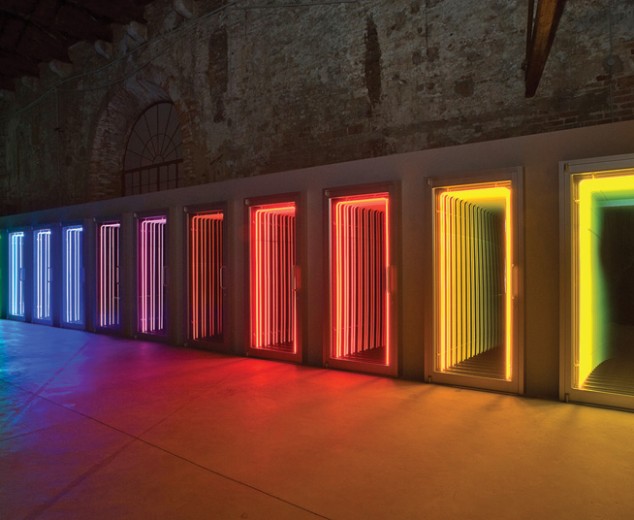Si chiude una porta, se ne aprono altre tredici!
Non ci si trova in una di quelle avventure oniriche dove bisogna scegliere quale porta attraversare per cambiare il finale della storia. Si tratta dell’opera Death Row di Iván Navarro (Santiago del Cile, 1972). Navarro realizza complesse sculture luminose basate sul principio che per ogni energia che si trasforma c’è qualcosa che si perde. Death Row è composta da tredici porte di alluminio con luce al neon al proprio interno, ognuna crea una cesura ottica nello spazio e l’inganno ottico di corridoi che attraversano il muro: una riflessione su cosa ci sia al di là delle porte attraverso le quali però è evidente che non si può passare. Pur presentandosi come piacevoli e giocose, le opere di Navarro frenano, infatti, il fruitore, negandogli l’esperienza totale dell’oggetto. Al contempo le sculture luminose dipendono totalmente dall’energia elettrica, che le anima come i fluidi corporei che donano vita all’essere umano.
One door closes, another thirteen doors open!
We are not in one of those dreamlike adventures where you have to choose which door to pass through to change the end of the story. It is the work Death Row by Iván Navarro (Santiago del Cile, 1972). Navarro creates complex and bright structures which are based on the principle that for every energy transformation, something gets lost. Death Row is made up of thirteen aluminum doors with inside neon lights; each one of these lights creates an optical caesura in the space, which contributes to the optical trick of corridors going through the wall: it is a reflection on what is actually beyond those doors through which is however evidently impossible to pass through. Although they are presented as enjoyable and playful, Navarro’s works actually restrain the beholder, denying a complete experience of the art piece. At the same time, his bright sculptures completely depend on electricity, which animates them as bodily fluids give life to human beings.

